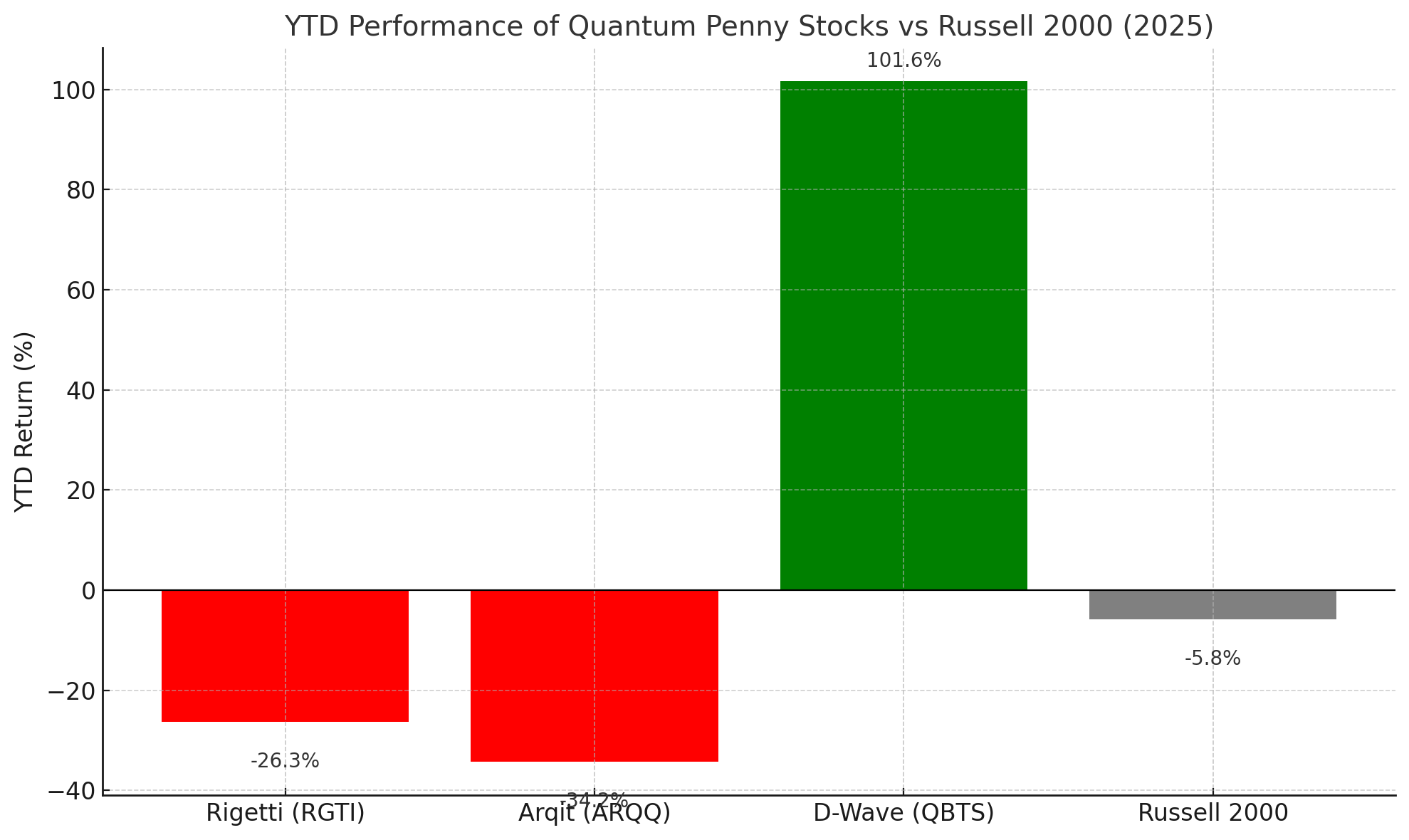Quantum Computing Penny Stocks
As the promise of quantum computing inches closer to commercial reality, investors continue to hunt for early-stage opportunities in the space—especially through speculative plays like quantum computing penny stocks. While the mainstream spotlight remains on giants like IBM and Alphabet, several lesser-known names have seen major moves in 2025.
This year has already served up a roller-coaster ride in the sector, with one breakout star and two under performers—each telling a different story about investor sentiment, risk appetite, and the fragility of moonshot tech investments.
YTD Performance: Winners and Losers
Here’s how three of the most talked-about quantum penny stocks have fared year-to-date as of mid-June 2025, compared to the Russell 2000 Index, a benchmark for small-cap stocks:
| Stock | Ticker | YTD Performance |
|---|---|---|
| D-Wave Quantum | QBTS | +101.6% |
| Rigetti Computing | RGTI | −26.3% |
| Arqit Quantum | ARQQ | −34.2% |
| Russell 2000 Index | – | −5.8% |
Below is a visual representation of these performance metrics:

Note: All figures reflect data up to June 17, 2025. Stock performance is subject to change.
Deep Dive on Each Player
🔼 D-Wave Quantum (QBTS): The Breakout Star
-
Performance: +101.6% YTD
-
What’s driving it? D-Wave’s launch of its Advantage2 quantum system has sparked investor optimism, showing early traction with enterprise clients in logistics and optimization sectors.
-
Investor sentiment: Bullish momentum, backed by technical developments and strategic partnerships.
🔽 Rigetti Computing (RGTI): Struggling With Execution
-
Performance: −26.3% YTD
-
Pain points: Persistent losses, cash burn, and a lack of clear commercial roadmap have eroded investor confidence.
-
Potential upside: Government contracts and collaborations with cloud providers remain a silver lining—if execution improves.
🔽 Arqit Quantum (ARQQ): Falling from Grace
-
Performance: −34.2% YTD
-
Challenges: Arqit’s pivot away from its original quantum encryption model to a more “pragmatic” software focus has left investors uncertain.
-
Warning signs: Allegations of misrepresentation in earlier projections continue to cast a shadow.
Benchmark Context: The Russell 2000’s Modest Decline
The Russell 2000 Index, which tracks 2,000 small-cap U.S. stocks, has dropped around 5.8% YTD. This backdrop highlights the headwinds facing early-stage companies more broadly—rising interest rates, tighter liquidity, and cautious institutional capital flows have constrained growth stock momentum.
Against this backdrop, D-Wave’s rally is even more remarkable, while the under performance of Rigetti and Arqit falls more in line with the broader trend.
What It All Means for Investors
Key Takeaways:
-
Volatility is the rule, not the exception. Penny stocks—especially those in speculative sectors like quantum computing—can swing dramatically based on single headlines or announcements.
-
A long-term horizon is essential. Most quantum applications remain years away from widespread deployment. Betting on winners now requires a deep understanding of the tech and patience.
-
Diversification is your ally. A basket approach may reduce the risk of total capital loss. Allocate no more than 1–2% of your portfolio to these plays, and consider pairing them with more stable growth assets.
-
Watch the catalysts. Upcoming earnings, funding rounds, government contracts, and research breakthroughs will likely drive the next wave of price action.
Final Thought
Quantum computing is no longer science fiction—but investing in its future requires a tolerance for high risk and ambiguity. In 2025, we’ve already seen fortunes swing wildly among the few publicly traded quantum penny stocks.
While D-Wave has delivered a breakout year, others like Rigetti and Arqit remind us just how fragile these moonshot ventures can be. If you’re intrigued by the bleeding edge of technology and willing to stomach the volatility, quantum penny stocks may deserve a small place in your speculative portfolio.
Just remember: in the quantum world, uncertainty isn’t just a feature—it’s a fundamental law.
About Russ Amy
Hey there! I’m Russ Amy, here at IU I dive into all things money, tech, and occasionally, music, or other interests and how they relate to investments. Way back in 2008, I started exploring the world of investing when the financial scene was pretty rocky. It was a tough time to start, but it taught me loads about how to be smart with money and investments.
I’m into stocks, options, and the exciting world of cryptocurrencies. Plus, I can’t get enough of the latest tech gadgets and trends. I believe that staying updated with technology is key for anyone interested in making wise investment choices today.
Technology is changing our world by the minute, from blockchain revolutionizing how money moves around to artificial intelligence reshaping jobs. I think it’s crucial to keep up with these changes, or risk being left behind.





